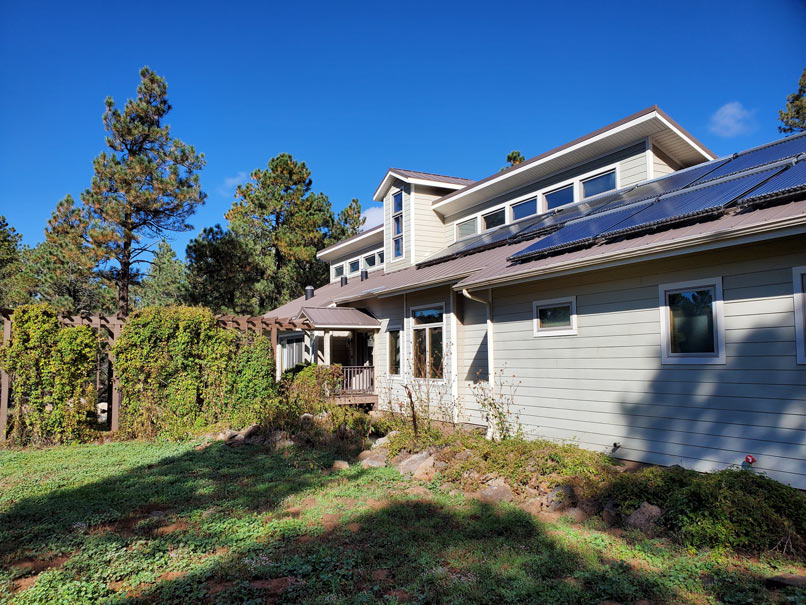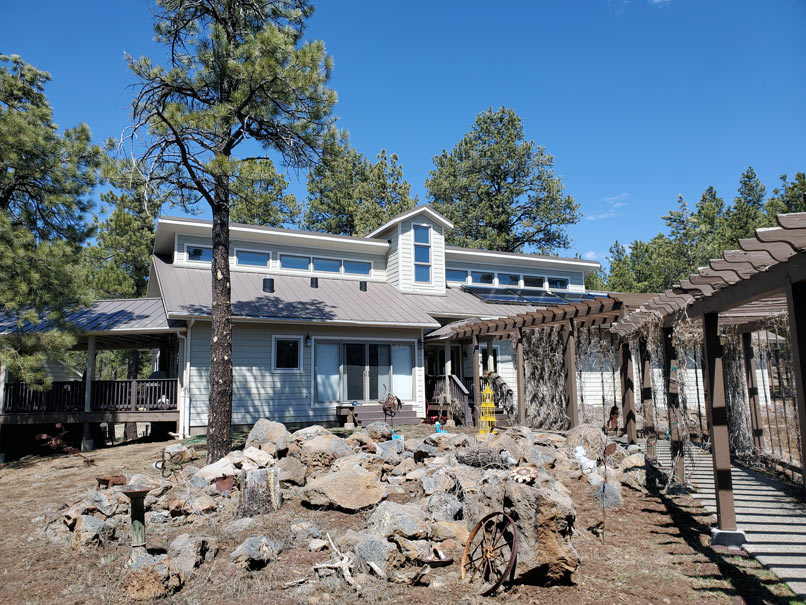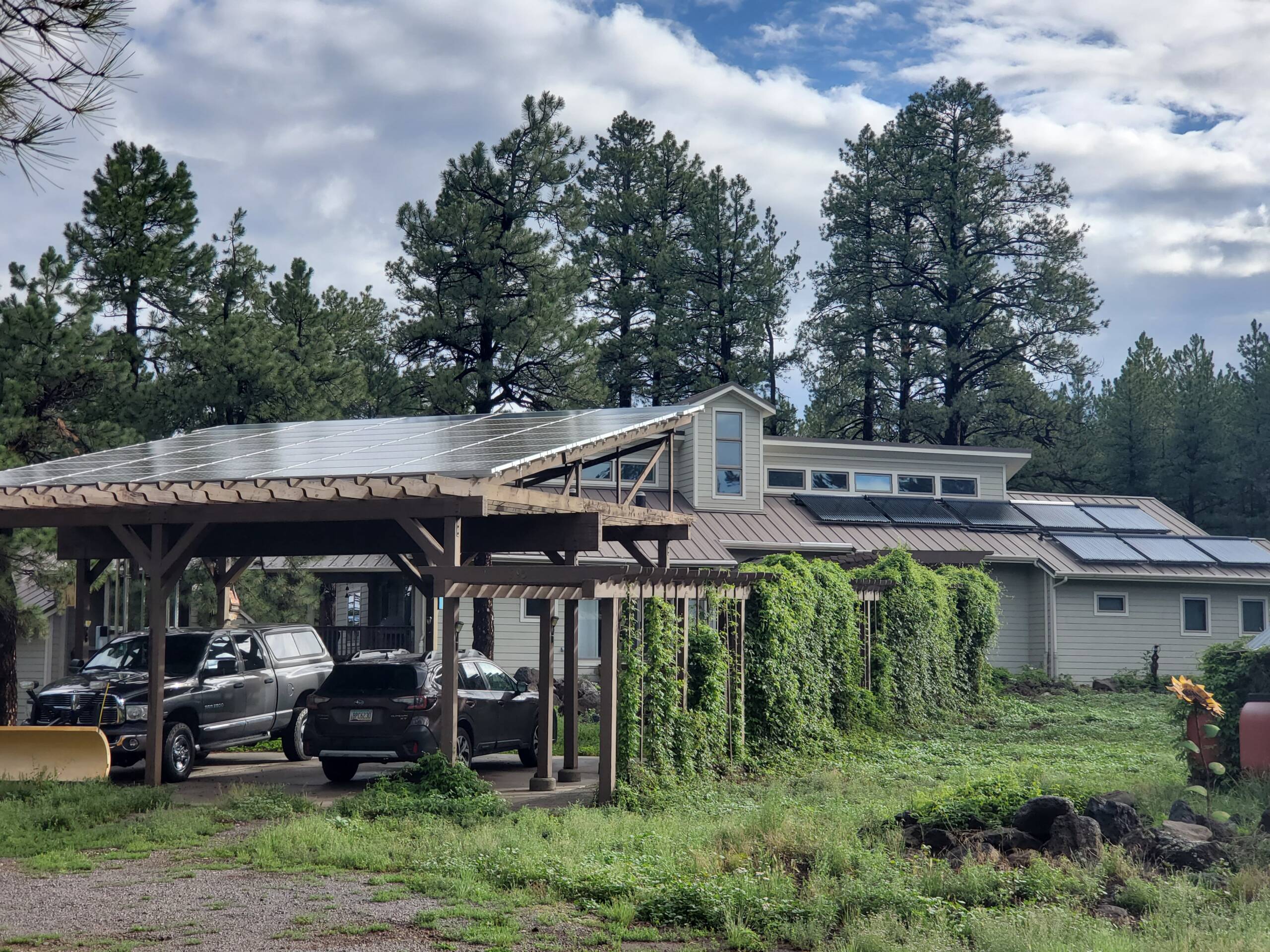Platinum U.S. Green Building Council (USGBC) LEED™ Pilot Home
Key Features
- The house is oriented on the site so that the long sides face south and north to improve “daylighting”, maximize passive solar heat gain, facilitate thermal as well as photovoltaic solar systems, and minimize western exposure.
- Sophisticated computer modeling is used to engineer the proper balance of south facing windows and interior thermal mass in order to retain the desired level of “heat” and “cool” within the structure.
- Electricity is provided by a 7.2 kW grid tied solar photovoltaic (PV) system with 24 six volt batteries for backup power. The backup system provides emergency power for critical loads like the refrigerator, house water system, recirculation pump for the radiant floor heating system, and the smart house computer system.
- Additional electricity is provided by a 1.8 kWh Southwest Wind Skystream 3.7 wind turbine. The PV and wind systems combine to make the house carbon neutral, a “zero carbon house”.
- Solar modules at the carport act as a roof that shades the hard paving reducing heat gain. The solar and wind tax credits, combined with the utility company rebates, total $24,600.00*.
- Waste products are processed by a “Noweco Singulair” system with UV light treatment. The system is less expensive and more attractive than a “Wisconsin Mount System”.
- A rainwater harvesting system collects 35,000 gallons from the existing and new building roofs. 10,000 gallons are allocated to potable water for the house and the remaining 25,000 gallons are used for irrigating landscape plant material onsite.
- Grey water (waste water from showers, bathtub, clothes washer, and bathroom sinks) is also recycled for addition onsite irrigation.
- The garage is detached to help improve air quality in the house by isolating combustion gases as well as fumes from paints and other chemicals that might be stored there.
- The design features significant outdoor living space (decking and patios) which provides additional usable area without expensive utility infrastructure and other building improvement costs.
- Radiant floor heating and domestic hot water are supplied by a solar thermal system.
- The house features “cooling tower” strategies where automated windows allow hot air to escape and cool air to enter (based on the concept of air stratification by which heated air rises).
- The house has no fireplaces, gas stoves, or other combustion appliances so no fossil fuels are burned and no pollution is created.
- The walls, floor and roof employ advanced framing concepts that can reduce labor and material costs (for framing) by up to 15%.
- Windows and exterior doors feature a high “R-value” (insulation) rating for increased energy savings.
- Structural Insulated Panels (SIP’s) are used on the exterior walls yielding a tight wall system (minimal air infiltration) and superior insulation (R-36).
- The house utilizes a passive radon removal system.
- There are termite and pest control shields at all exterior walls.
- A central vacuum system is installed to increase indoor air quality (IAQ) by minimizing entrainment of microscopic material back into the indoor air after vacuuming. These microscopic particles are exhausted to the outside instead.
- The attic and crawl space feature advanced sealed and insulated construction methods with no air vents to the outside. This provides superior control of indoor temperature and air quality.
- Indoor air quality is further improved by using all hard surfaces for flooring (no carpeting which collects particulates, dirt, mold, bacteria and other pollutants).
- No- or low-chemical or Volatile Organic Compounds (VOC’s) materials or building methods are used in the construction process. Precautions, such as “sealing” the surfaces of OSB sheathing to prevent formaldehyde off gassing, are common in the home.
- Many recycled, low or no chemical, sustainable, eco-friendly primary construction materials are utilized. These include recycled steel roofing with “cool roof value”, recycled aluminum gutters, Structural Insulated Panels (SIP’s) at exterior walls, engineered framing materials (uses scrap wood) Hardiplank exterior lap siding, porous pavers at patio, low or no VOC caulking to seal the home, sealing all OSB (contains formaldehyde) sheathing to improve interior air quality, and the use of beetle kill Ponderosa Pine with low or no VOC finishes on all cabinetry.
- All appliances and interior lighting fixtures are EnergyStar rated and all exterior lighting features “dark sky” fixtures.
- Interior finishes feature eco-friendly sustainable products like clay paint, American Clay wall finishes, recycled ceramic floor and shower tiles, cork flooring, recycled rubber and cork sheet flooring, concrete countertops with fly ash, agri-board and “Kirei” board shelving (made of waste straw), as well as use of low or no VOC caulking and adhesives. These products improve indoor air quality, reduce chemical exposures, and encourage recycling.
- The use of low-flow toilets, shower heads, and water faucets increases water conservation.
- Water heaters are installed within 20 feet of the point-of-use faucets and employ “D-Mand” hot water supply pumps to reduce energy requirements for domestic hot water.
- Automated controls (Smart Home System) are used for heating and cooling, and for monitoring technical as well as environmental data for the home. This includes the amount of rainwater collected, amount of water consumed, amount of electricity generated, temperature inside and outside of the building envelope, indoor humidity levels, a rain sensor to shut down the drip irrigation system, wind speed and direction, wind chill, window and door status (open/closed), lighting use, heat or smoke detection, entry alarm system, and other critical data.
- A Steam Humidity System with individual sensors is installed to maintain interior humidity levels at an optimum 45%. High Efficiency Particulate Air (HEPA) filters are used to maintain superior interior air quality.
- Very quiet air exchange units bring fresh air into the house and exhaust air from the bathrooms and kitchen. This allows the incoming air, by way of an exchange manifold, to capture the “heat” or “cool” of the exhausting air so that energy is not lost.
- The site has been engineered to prevent erosion with minimal disturbance of the existing natural features. Storm water is retained onsite for use with natural landscaping.
- The landscaping features only native grasses as well as native drought tolerant, regionally adapted plantings.
* Other tax credits and rebates for using grey water, energy efficient design, and energy efficient construction amount to approximately $12,000.00 for the house.




